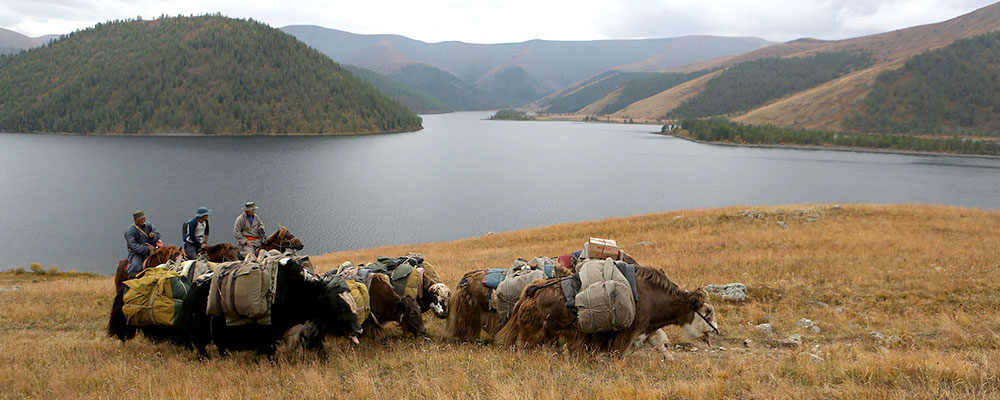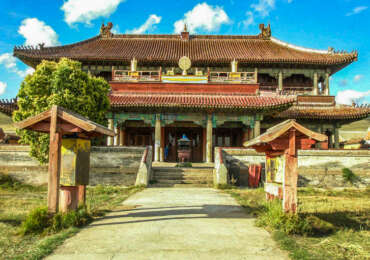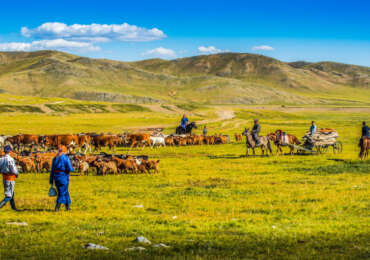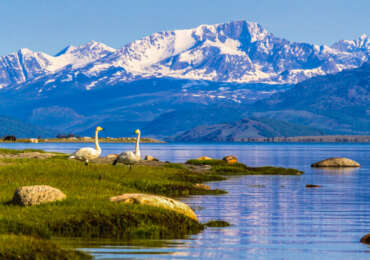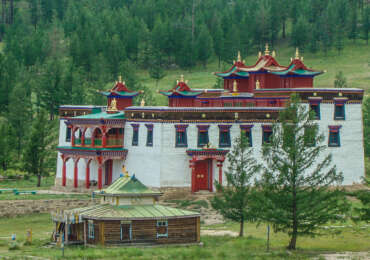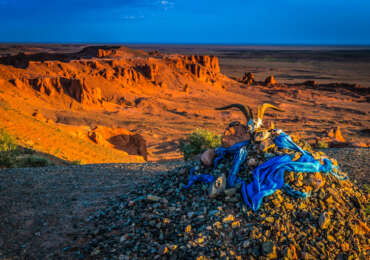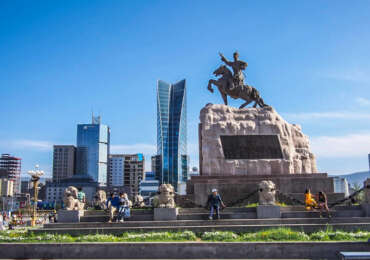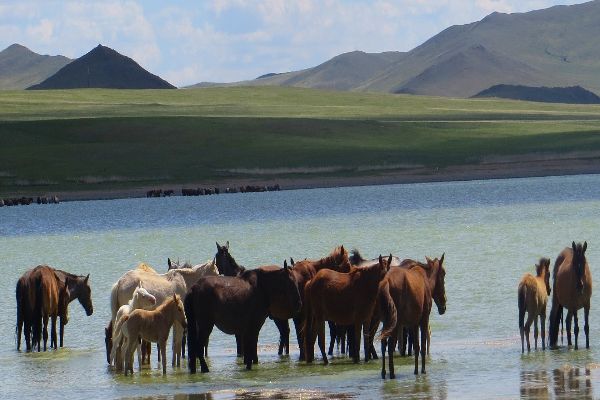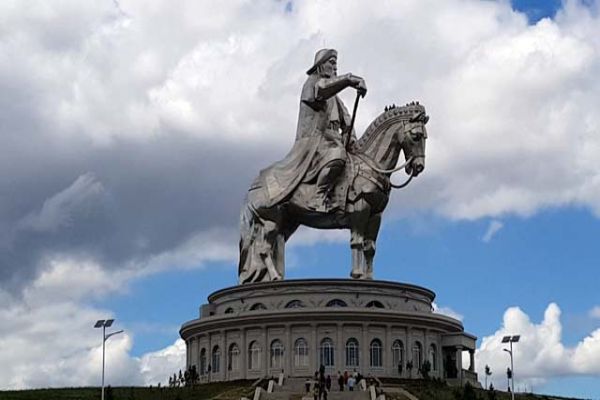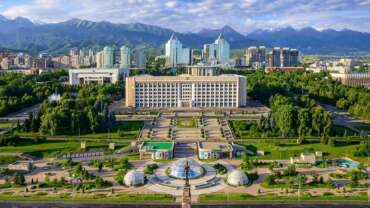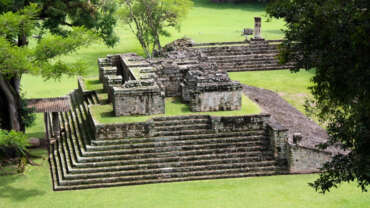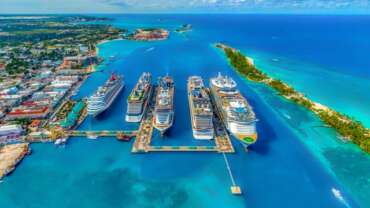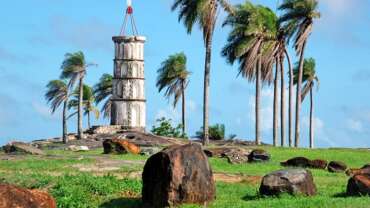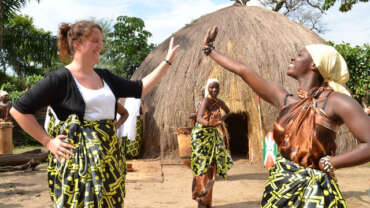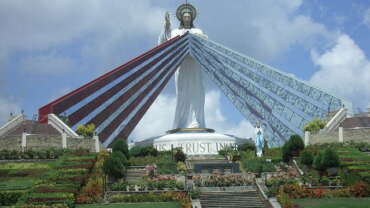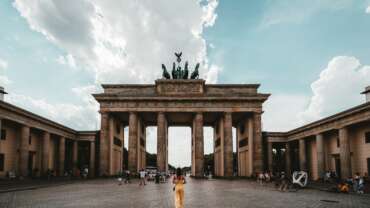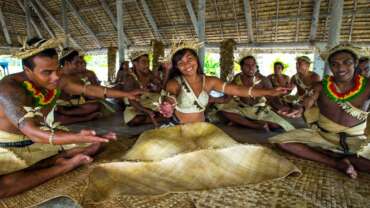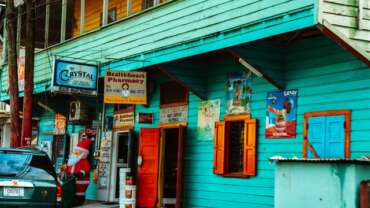Mongolia - Go Nomadic, Experience Mongolia
Mongolia, a nation bordered by China and Russia, is known for vast, rugged expanses and nomadic culture. Its capital, Ulaanbaatar, centers around Chinggis Khaan (Genghis Khan) Square, named for the notorious founder of the 13th- and 14th-century Mongol Empire. Also in Ulaanbaatar are the National Museum of Mongolia, displaying historic and ethnographic artifacts, and the restored 1830 Gandantegchinlen Monastery.
History of Mongolia
Mongolia’s history is extremely long; it spans over 5,000. “The Mongols has little inclination to ally with other nomadic peoples of northern Asia and, until the end of the 12th century, the Mongols were little more than a loose confederation of rival clans, It was in the late 12th century that a 20-year-old Mongol named Temujin emerged and managed to unite most of the Mongol tribes. In 1189 he was given the honorary name of Genghis Khan, meaning ‘universal king’. No Mongolian leader before or since has united the Mongolians so effectively.”
Manchu controlled Mongolia from the year 1691 to 1911. Thanks to the fall of the Manchu dynasty that controlled stopped. A group of Mongol princes “proclaimed” the living Buddha of Urga to be ruler. “Mongolians have always taken wholeheartedly to Tibetan Buddhism and the links between Mongolia and Tibet are old and deep.” In 1921 there were 110,000 lamas or monks in Mongolia living in 700 monasteries. In the 1930s thousands of monks were arrested. Some believed that by the year 1939 3% of Mongolia’s population, at the time, was executed or out of 27,000; 17,000 were monks.
In the year 1990 the freedom of religion returned. Since then a revival of Buddhism and other religions has occurred. Mongolia won its independence in 1911. In 1921 the Mongolian People’s Revolutionary Party government started. “When the last living Buddha died in 1924 (“with the rise of Tibetan Buddhism in the 16th century, a living Buddha would be named”), the Mongolian People’s Republic was established. It took 22 years for China to recognize this. All subsequent Monolian texts were written in script until Stalin forcibly replaced it with Russian Cyrillic in the 1940s. The text was written in scripts named SECRET HISTORY scripts. Since 1944 the Russian Cyrillic alphabet has been used to write Mongolian.
A new constitution came into force in 1960, and Mongolia was admitted to the United Nations in 1961. Mongolia traditionally supported the Soviet Union. In January 1992 the president of Mongolia, Ponsalmaagiyh Ochirbat institute a new constitution. “In 1993, Birus Yeltsin, Russia’s president and Ochirbar signed a new treaty.” Also Ochirbat was re-elected in 1993.
In the 1980s Mongolia fell in control of Jambyn Batmonkh, a decentralize heartened by the Soviet reforms under Mikhail Gorbachev. “By the late 1980s, relations with China even started to thaw and full diplomatic relations were established in1989. “In March 1990, large pro-democracy protests erupted in the square in front of the parliament building in Ulaan Baatar and hunger strikes were held.” Also lots of things happened at a rapid paste around that same month. Some of which are: Batmonkh lost power; new political parties sprang up; and hunger strikes and protests continued. In May Mongolia was awarded from the government to have multiparty election in June 1990. The communists won the elections. In the first half of the year 1996 Mongolia was “beset” by wild fires that raged for more than three months and lost 41,000 sq mi (106,000 sq km) of forest and rangeland. In the year 1997 Ochirbat lost the election because of the economy. In the year 2000 the elections resulted in nearly a total win for the MPRP. In fact the total amount of seats won by the MPRP was 95%.
People of Mongolia
Mongolian Ethnic
Mongolian Ethnic – Unique type of nation
Although most people probably think of Mongolia as being inhabited by a single ethnic group – the Mongols – this is wrong. There are actually quite a few. There are over 20 different groups of Mongols.
Ethnic group, Percentage of total population:
Khalkh (Халх) – 84.5%
Kazakh (Казах) – 3.9%
Dörvöd (Дєрвєд) – 2.4%
Bayad (Баяд) – 1.7%
Buriad (Буриад) – 1.3%
Dariganga (Дариганга) – 0.9%
Zakhchin (Захчин) 1.0%
Uriankhai (Урианхай) – 0.8%
Khalkh
The Khalkh are the largest group of Mongols in Mongolia. In fact, they are the core of all the Mongol peoples across North Asia. The Khalkha Mongols are considered the direct descendants of Chinggis Khan and therefore, the true preservers of Mongol culture.
In the thirteenth century, Chinggis Khan formed one of the greatest empires in world history by uniting all of the nomadic Mongol tribes. The Khalkha Mongol language, Halh, is the main Mongolian language, since all other Mongols speak variations or dialects of Halh. Halh is understood throughout Mongolia and by Mongols living in Central Asia.
Kazakh
The Kazakh of Mongolia belong to a larger group of people who live primarily in Kazakstan. Ethnically, they are of Turkic descent, and are the second largest Muslim group of Central Asia.
The Kazakh developed a distinct ethnic identity in the late fifteenth and early sixteenth centuries. In the nineteenth century, the Russians acquired Central Asia through a steady process of annexation.
The Kazak who now live in Mongolia make up the largest non-Mongolian ethnic group in the country. At the present time, their number is decreasing since many are emigrating back to their homeland, Kazakstan.
Dorvod
The Durbet are a Western Mongol tribe. They are primarily located in the western part of Mongolia, near the border of Russia. In the early 1600’s, most of their ancestors (the Oirat) left their homeland, Dzhungaria, which is now part of the Xinjiang region of China, in hopes of settling in the rich pastures of the northern Caucasus Mountains.
In 1771, the majority of the Oirat decided to move back to Dzhungaria in order to escape the Russian dictatorship. Those who stayed in Russia became known as the Kalmyk, which means “to remain.” Of those who left Russia, only a small group survived the long and difficult journey back to Dzhungaria.
Having arrived in the land of their ancestors, the surviving Oirat were accepted under Manchu rule and given pastures for grazing their herds. Their descendants are still found in western Mongolia.
Bayad
The Bayad people are one of the Mongol tribes, residing in western Mongolia. In the 13th century the term “Mongol” grew into an umbrella term for a large group of tribes united under the rule of Chinggis Khan.
Ethnic distinctions among the Mongol subgroups are relatively minor. Tribal differences are usually not a political or social issue as the Mongols are a generally peaceful nation.
Buriat
The Northern Mongolians, also known as the Buryat, are believed to be the descendants of the western Mongols and the northern Siberians. They primarily inhabit the forested lowland regions along the Russia-Mongolia border. The territory that once belonged to the Northern Mongolian’s ancestors includes the regions along Lake Baikal, which is located in present-day Siberia.
Three quarters of all Northern Mongolians still live there, in a region that is now known as the Buriat Autonomous Republic.
The Northern Mongolians are very similar to the Khalkha Mongols, particularly in their physical features, dialects, and customs. In fact, they are often indistinguishable from neighboring Mongol tribes. However, they maintain a number of small differences, the most significant of which is their language.
Dariganga
The Dariganga, a small people group of Mongolian origin, inhabit the southeastern regions of Mongolia. They are primarily located in the southern part of the Sühbaatar province, on a volcanic plateau near the Gobi Desert. The Dariganga belong to the eastern group of Mongols, which includes the Khalkha Mongols, the Buryat, and most of the Chinese Mongols.
The Dariganga language is closely related to Halh, and is often referred to as a Mongolian dialect. However, all Dariganga are also able to use Halh in conversation with other Mongols in North and Central Asia.
Zakhchin
The religion of the early residents of the Mongolian region recognized only one uniform godly power, localized in the celestial vault. They also worshiped certain natural phenomenon, and believed in a life after death in the form of spirits (demons).
The artwork of the people, their great poetic talents, their epic works and the lyric poetry are outstanding. Singers and poets used to walk from camp to camp, singing their songs and epics, reflecting the expression of freedom and the immensity of the Mongolian steppes.
Uriankhai
The Tuvinian in Mongoloia inhabit a harsh mountainous region in the northern part of the country, near the border of Russia. There, the summers are hot and dry, while the winters are bitterly cold. Still, this region can have as many as 300 sunny days a year, and the extremely dry air helps people to withstand the cold winters and the hot summers.
Because the Tuvinian, like other Russian settlers, left their home territories in the Soviet Union many years ago and immigrated to Mongolia; their present “national” status is disputed. Some Tuvinian clans in Mongolia have maintained their native language, ethnic background, and traditional culture.
Other Tuvinian clans have been absorbed by the Mongolian culture. Their original language, Tuvin, contains many Mongolian words and uses the Cyrillic script. Most Mongolian Tuvinian also speak Halh, the national language of Mongolia.
Religion in Mongolia
YELLOW HEADED BUDDHISM BEGAN TO ENTER INTO MONGOLIA FROM TIBET THE SECOND HALF OF THE 16TH CENTURY.
Buddhism: Buddhism in the form of the yellow hat Buddhism or Lamaism making further inroads into Mongolia from the second half of the 16th century. According to the Mongolia Buddhist doctrine, it is said that the sky father blessed all of the world and that there is one who could say, I am a owner of the world’ Buddhism teaches the ‘nature of reason’ and that if good deeds are done, they will have good results. Similarly if bad deeds are done, they will have bad results. Buddhism preaches about these as ‘ten black deed sins’ and ‘ten white deeds’. Sins are divided into deeds which are made with the body with speech or with the mind through thoughts. Sins made with thoughts include thinking about bad things having evil thoughts, corruption, intentionally or purposely doing a crime, planning aggressive war, and so forth.It is said that Buddhism believes that thought is thing prior to both body and speech. They consider evil thoughts the result of numerous sufferings and unavoidable accidents and misfortune. The term used for such negative feelings is Nirvanas (greed, anger, opposed, ideology). Buddhism argues that if we can systematically remove these strong desires or greed from the mind we can become wholly enlightened people. With enlightenment, thoughts will become pure and clean and reach to the height of bliss. Buddhism also teaches that if the people show their mercy in letting an animal live, they will gain merit in their future lives.
Since Buddhism began to enter into Mongolia, mostly Mongolians believe Buddhism. But Mongolian Buddhism is different from Tibetan Buddhism. Mongolian Buddhism connected with Mongolian traditional lifestyle. Before in 1930 40% of male population was lamas (monks). Between the communist purges 1930-1940 Russian and Mongolian soldiers destroyed about 700 monasteries and temples. Until in 1990 any religion closed in Mongolia. After democratic movement in 1990 all religion reopened. In 2002, there are about 180 religious temples and churches operating in Mongolia and more than 110 Buddhist monasteries and temples and about 70 Christian churches in Mongolia.
Buu (Shaman): Mongolian classics, such as The Secret History of the Mongols, provide details about male and female shamans serving as exorcists, healers, rainmakers, necromancy, soothsayers, and officials. Shamanic practices continue in present-day Mongolian culture.
The spiritual hierarchy in clan-based Mongolian society was complex. The highest group consisted of 99 tengri (55 of them benevolent or “white” and 44 terrifying or “black”), 77 natigai or “earth-mothers”, besides others. The tengri were called upon only by leaders and great shamans and were common to all the clans. After these, three groups of ancestral spirits dominated. The “Lord-Spirits” were the souls of clan leaders to whom any member of a clan could appeal for physical or spiritual help. The “Protector-Spirits” included the souls of great shamans (ĵigari) and shamanesses (abĵiya). The “Guardian-Spirits” were made up of the souls of smaller shamans (böge) and shamanesses (idugan) and were associated with a specific locality (including mountains, rivers, etc.) in the clan’s territory.
In the 1990s, a form of Mongolian neo-shamanism was created which has given a more modern approach to shamanism. Among the Buryat Mongols, who live in Mongolia and Russia, the proliferation of shamans since 1990 is a core aspect of a larger struggle for the Buryats to reestablish their historical and genetic roots, as has been documented extensively by Ippei Shimamura, an anthropologist at the University of Shiga Prefecture in Japan. Some Mongolian shamans are now making a business out of their profession and even have offices in the larger towns. At these businesses, a shaman generally heads the organization and performs services such as healing, fortunetelling, and solving all kinds of problems. Although the initial enthusiasm for the revival of Mongol shamanism in the post-communist/post-1990 era led to an openness to all interested visitors, the situation has changed among those Mongols seeking to protect the essential ethnic or national basis of their practices. In recent years many associations of Mongol shamans have become wary of Western “core” or “neo” or “New Age” shamans and have restricted access to only to Mongols and Western scholars. One such event, organized by Jargalsaiкhan, the head of the Corporate Union of Mongolian Shamans, was the 21 June 2017 Ulaan Tergel (summer solstice) celebration held near midnight on the steppes about 20 km outside Ulaanbaatar.
Art & Culture of Mongolia
Visual Art of Mongolia
Cinema
Cinema, the miracle of the 20th century, came to Mongolia in 1910s. First movies were shown in the capital city, at the American Consulate and Russian Stock Exchange’s hotel. In 1913 Mongolian prince Namnansuren is known to have brought some films from Russia to show at the residence of the Bogd Khan. After the revolution of 1921, equipment and movies have been purchased and students trained in Russia . Thus people have acquired access to cinema. At that time, cinema in Mongolia was called “Shadow show”, and it was free of charge, until the first cinema theatre “Ard” was built in 1930s. In 1935, under the decision of the Council of Ministers, a movie production company “Mongol kino” was set up with Soviet assistance. The first production of the company was a documentary “74th Celebration of 1st May”. In 1936, the first feature movie created with the technical assistance of the Soviet “Lenfilm”. Mongolia ‘s first movie directors, cameramen, editors and other personnel were trained on the job by professionals from the Soviet Union . And in 1938 Mongolians were able to make independently “Norjmaa’s way”, and “Wolves” in 1939. Movies directed by the famous Mongolian film director D.Jigjid, such as “Tsogt taij” (1945), “People’s messenger” (1959), “Flood”, “Son-in-law” and others have became classics of Mongolian cinema. Film directors of younger generation, such as H.Damdin, Ts.Navaan, Ch.Gombo, B.Baljinnyam, B.Sumhuu and O.Urtnasan have made their unique contribution to further development of Mongolian cinema. The 1990s have became a turning point in the history of Mongolian cinema. Around 20 private film studios that have emerged between 1992 and 1997, produced more than 100 feature movies. Foreign relations with films companies have expanded as well. Joint productions of both documentary and feature films with French, Japanese, Chinese and Mongolian film producers have successfully participated in various international film festivals.
Fine Art
Fine arts of Mongolia are famous for its incredible paintings. Cave paintings aged 3-8 thousand years and found in the Khoid Tsenkher cave, Munkhan somon of Khovd aimag, are considered the first works of art discovered in the territory of Mongolia . The history of art and architecture of the Mongolian Empire begins in the 12th century and at later times was influenced by other nations. The capital city of the Mongol Dynasty, Khar Khorum, was a magnificent proof of the glory and majesty of the Mongolian Empire. With the development of religious arts and architecture, in 16 to early 20th century, design of buildings acquired features of Buddhist temples. Many monasteries were built during this time. Works, that represents today’s classical painting techniques, are U.Yadamsuren’s “The Old Horse-fiddler”, A.Senghetsokhio’s “The Mongol Lady”, B.Avarzed’s “Uurgach” and Ts.Minjuur’s “Caravan Guide”.
Modern Art
A new social system which was founded upon the victory of Revolution in 1921 was focused on art works. Therefore art works of that time were dedicated to publicity of he new system. Since then Mongolian artists became acquainted with European paintings and began using both Mongolian and European drawing methods. In order to develop Mongolian art systematically specialised artists were prepared and there were established specialised agencies in Mongolia . In 1950s many genres of fine art, carpet and porcelain production were introduced and developed. During this period many artists and architects became very famous for their single thematic works, namely, painter O. Tsevegjav-animals, U.Yadamsuren-workers, N.Tsultem and G.Odon-history and everyday life, L.Gavaa-nature and an architect S.Choimbol-monuments etc. In 1960s there was a great change in the tradition of art-refusing to use linear perspectives, harmonisation of colours and colour endowments in every respect and began to use other techniques of painting as well as themes and contents of art were expanded. Famous artists of 1970-1980 are D.Amgalan who mastered xylography, M.Butemj, Ya.Urjnee, G.Soosoi, M.Chuvaamid who mastered monumental arts, S.Dondog, B.Chogsom, M.Tsembeldorj and D.Munkhuu etc. On beginning democracy in Mongolia since 1990 there has been a change in the social life and in the sector of arts and culture. As Mongolia expands its foreign relations, artists and architects of Mongolia are provided with possibilities of studying and creating abstract and impressionist arts which were unfamiliar to Mongols.
Painting
Mongolian painting began to develop more than two thousand years ago from simple rock drawings. Uighur paintings of the 8th century prove that this art was flourishing in Mongolia and Asia long ago. Buddhism was the main theme of the painting. and it developed into a fine art form. B. Sharav is the painter who linked the old with the new in his art. The Mongolian way of life was depicted in his famous work “One Day in Mongolia ” and various portraits. The traditional painting was influenced by European art. The Mongolian painters L. Gavaa, O. Tsevegjav and Ts. Dorjpalam are famous not only at home, but also abroad. They made a great contribution to the creation of new art based in tradition and trained several generations of painters. At present, new and different artistic trends are emerging, and creative young artists are developing the national art.
Sculpture
Deer carvings in rock constitute the historical monuments of ancient times. Thousands of these rocks are evidence of the development and wealth of sculpture in ancient Mongolia . Undur Gegeen Zanabazar, a prominent religious figure and famous sculptor of the 17th century, created 21 tare (consorts of Buddha), which show the beauty of Mongolian woman. Zanabazar laid the foundation for the depiction and praise of the human form in Mongolian sculpture. Now there are many famous sculptors such as S. Choimbol, A. Davaatssren, N. Jambai and L. Dashdeleg. The monument to D. Sukhbaatar by S. Choimbol is a symbol of Mongolia and it gives an idea of our country to foreign visitors. It is a unique example of a Mongolian horse-rider represented through the medium of sculpture. It is hoped that creative young artists will further contribute to sculpture in Mongolia.
Nomad lifestyle
Mongolia is one of the nomad countries in the world. Mongolian nomadic people move into place to place 2-4 times a year.
Since the Hun Empire, Mongolians have been raising their five domestic animals. This includes sheep, horse, cow, camel, and goat in the broad region of forest, steppe and Gobi desert. Mongolia has 4 seasons and nomadic people move into place to place 2-4 times a year as well as it is depending on livestock’s pasture. Mongolian nomad people always following their livestock. Because livestock knows where is the best pasture. Mongolian herders live in Mongolian traditional dwelling (covered felt) Ger.
Mongolian livestock
Mongolian five domestic animals are sheep, horse, cow, camel, and goat. Mongolia is the land of livestock. Now in Mongolia has over 55.9 million livestock, including 24.9 million sheep, 23.6 million goats, 3.8 million cattle, 3.3 million horses and 367.9 thousand Bactrian camels.
On these five animals depends the prosperity of the country. The sheep and goat provide mostly meat, wool and leather. The cow is eaten and milked, and its hide provides leather often the yak is used instead of the cow, or else together with cattle. The she- yak’s milk is fatter. The yak seems more active than the cow, and as one approaches a mixed herd, the yak’s – hairy as terriers – are always the first to run off, lofting their- feathery tails like pennons. Also there is hainag, a yak cow hybrid. (The reverse hybrid, from a Mongolian bull with a female yak, is possible, but not used.)The male hainag is strong, stronger than either parent. It is burly beast with hair longer than its mother’s and shorter than its father’s. The female produces more milk than the female of either parental stock. But its calf, the ortom, is a weakling, and breeding is not taken other.
The horse is kept as a mount and for milk. Mares must be in foal a great part of the year. Several times in journey you will come across twenty or thirty horses crowded, noses together close to Ger. Mongols say they milk better if you let the foal start them. The means of transport is the camel. His wool warm to the rider, is taken also. But he is not eaten, nor his female milked, save perhaps on the edge of the desert where no other livestock viable. Camels are formidable. The males, when their minds are on mating, foam at the mouth and fight. Camel herds are usually smaller than those of other animals. Camels and coats are shorn but once a year. Sheep sometimes twice. A Mongolian sheep gives three or four pounds of wool a year.
Mongolian Traditional Clothes
The traditional dress of the Mongols has a rich history spanning many centuries. It is closely connected with the Mongolian way of life and the country. The costumes of elderly people are, as a rule, modest and plain. The female dress shows differences between the attire of the girls and that of married women. The nomads’ wardrobe is compact but has many variations able to serve for different purposes. “It is amazing how this nation invented clothes that can fit all seasons and needs, well thought off and used in many different ways,” wrote Medieval travelers from Europe.
THE MONGOLIAN TRADITIONAL COSTUME CONSISTS OF HAT, DEEL,BOOTS AND ACCESSORIES.
Hats
One of the most colorful and original items of Mongolian national dress is the traditional headwear. The Mongolian headdresses differed in shape and purpose; there were hats for the young and old, summer and winter & men & women, holidays and ceremonies & fashionable and everyday hats. Their fashion and trimmings & colors were amazing varied depending on the sex of the person wearing it his or her social position or to who’s tribe or nationality they belonged. There are 400 different styles. For example, the cone-shaped top of the hat (blue or red) had 32 stitching symbolizing the unification of 32 Mongolian tribes.
The middle ages women & men wore summer hats made of plush wet velvet upturned brim &brocaded pointed tops. The hat has crowed with a fanciful knot. In ancient times it symbolized power capable of frightening enemies. In summer Mongols wore either the hat or flat-topped “Toortsog” hat consisting of six gores. The toortsog had an upper and a lower part. The upper part was not one piece but was sewn from six separate pieces.
Married women were not permitted to wear this hat, only girls & men. Women’s holiday headwear was noted for it is original and richness of adornment. It consisted of holiday silk and velvet hat and a complete decorative set for the hair the lower part of the hat was made from velvet and the upper part from red silk. The hair holder was covered with coral, pearl, and mother pearl. The Shanaavch the temporal adornment with little silver bells was fixed to the hair holder. The “Tolgoin boolt” was a headdress usually made of silver and studded with a precious stone and semiprecious stones. Women’s hats were more fashionable than men’s, and the ribbons on them were decorated with turquoise.
Deel
The Deel is a loose calf-length tunic made of one piece of material. It has long sleeves, a high collar, and buttons on the right shoulder. The Deel buttons. If they are not commercially produced from decorative stones or silver, they are narrow strips of cloth tied into intricate knots. Each ethnic group living in Mongolia has its own individual Deel, distinguished by its cut, color, and trim. These distinctions go unnoticed by foreigners but are obvious to Mongolians. Before the Revolution, all social strata in Mongolia had their own manner of dressing. Live stockbreeders, for instance, wore yellow deels with a cape thrown over it.
There are basically three types of deels, each worn during a particular season. The “Dan Deel” is made of light, thinks bright materials and is worn by women during the late spring and summer. The “terleg” is a slightly more padded version and both men and women. The winter Deel is serious, padded tunic lined with sheepskin, or layers of row cotton. Deels have the same cut whether worn by men or women. Male deels are just wider and in more somber colors. The Deel for everyday wear is gray, brown or some other dark color, white the holiday Deel is bright blue, green or claret silk with a silk sash of contrasting color several meters long. The sash is not simply adornment. It also serves as a soft corset facilitating long riders on horseback.
A Deel has wide, cup-shaped sleeves nicknamed “hooves”. There is a legend that the Manchu’s introduced this to make the Mongols the same as their horses. But it is a highly useful feature of the Deel protecting the hands from the cold and from injures while doing hard work. Also, the shape is the same golden and silver ingots. The khantaaz is a shorter traditional jacket, often made of silk, which is also buttoned to the side, and usually worn over the Deel.
Boots
The toes of boots are upturned, and several explanations have been offered for this unconventional style. If boots had upturned toes pre 1578 when Buddhism introduced to Mongolia, then this would be an example of religion using indigenous customs, beliefs, etc. to support advance their own religion. Another explanation is that the upturned tip prevents a rider’s feet from slipping out of the stirrups. However, it’s also true that boots are so thick and rigid that if they were flat, they would be almost impossible to walk in.
These hefty boots are still worn in Ulaanbaatar and are particularly popular in the countryside. The boots are tall boots made from thick unbending leather “buligar” and the tops are decorated with leather appliqués. The right and left boots are the same shapes. They do not have laces or zippers, making them easy and quick to slip on or off in a hurry. And they can be worn in all sessions with thick felt socks added in winter and removed in summer.
Accessories
Traditional accessories are usually made of silver. Mongolian women usually wear a pearl head dressing and silver earrings with pearls.
Come to Mongolia - It's all yours!
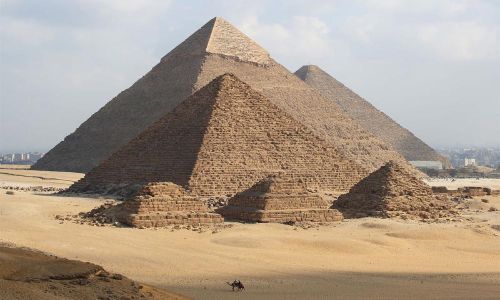
Mongolia is truly one of the world’s last undiscovered travel destinations and the safest country to visit. It is a land where you can experience wide-open spaces, cobalt blue skies, forests, deserts, crystal clear rivers and lakes, and the traditional hospitality of the nomads. Permanent dwellings are few and far between, fences even fewer and the land is owned by the people, like one large National Park. As a tremendous destination to experience the outdoors, Mongolia also boasts of unique history dating back to the Mongol Empire of Genghis Khan. Simply put, it is a land of adventure, horses, nomads, and blue sky.



